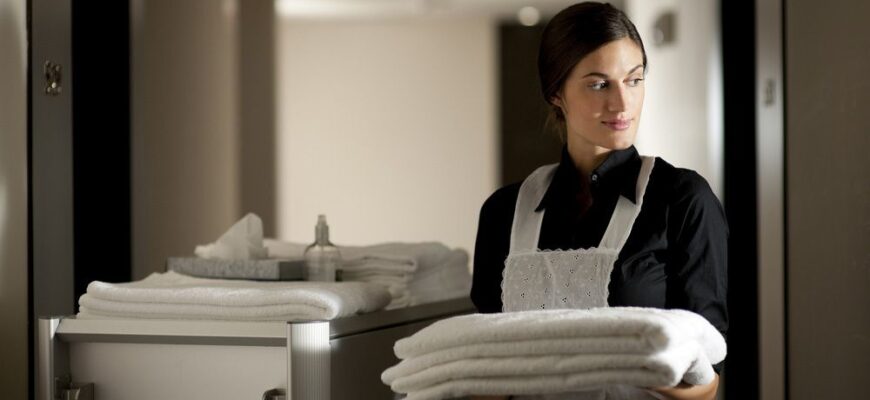- July 16, 2023
- in Commercial Cleaning, House Cleaning
- by Alionservice
- 182
- 0

First of all, let’s just start by saying that not every hotel room is secretly swarming with skin cells of past guests, E. coli, and/or unidentified bodily fluids. Every hotel has different protocols, schedules, and cleaning staff that determine just how clean your temporary home is going to be. But just because your room looks spic-n-span doesn’t necessarily make it so.
We aren’t dumb (and neither are you) we know that not all maids are spending hours scrubbing buffing, and spraying down every surface and crevice of our hotel rooms. But after digging we uncovered some pretty dirty secrets of hotel” cleaning” practices, hiding in the sheets, on your pillows, across the bathroom counter in the glass you drink from-pretty much everywhere
Think you’re better off not knowing about how dirty the bedsheets are or what infectious bacteria are colonizing that remote control? Trust us, it’s better to know how to deal with it and we’re here to help,
So what Exactly Should You Be Looking Out For?
When researching hotel cleanliness we noticed a few of uncleanliness that are legitimately hazardous to your health. Off the charts, repeat offenders included drinking cups and mugs remote controls light switches faucets, and maybe the most unnerving bedding. According to the official report of 2015 and 2016 Canadian hotel room inspections dirt mold and germs get ballsy. They not only hide out in dark unseen crevices like air conditioning vents but can be found unapologetically out in the open. On-the-spot pathogen tests performed in these studies and others found that hotel room remote controls were breeding grounds for thousands of bacteria like E. coli (spoiler alert that means feces) staph and the highly contagious and something delay MSRA along with other dangerous germs. thanks but no thanks
Don’t even get us started on the beds. Investigations done with hidden cameras the naked eye and UV light uncovered some nasty things under the covers nail clippings hair fluffed but not chand pillows and scores of unidentified fluids (also found on some seemingly spotless drapes). Studies have also knobs are cleaned and thus become popular hosts of pathogen parties. Is it just us or does it seem counterproductive to have the sink area where we wash our hands crawling with bacteria? And speaking of counters these were also home to tons of bacteria and for the same gag-inducing reasons you should probably shy away from those shiny glasses and mugs.
Is It Really That Bad?
Okay, we’re all adults here. We can handle it. Here’s the nitty gritty on why your room isn’t as clean as it looks.
Glasses and Mugs
Those sparking glasses hanging out by the sink. Chances are they haven’t left the room in ages. It seems hotel mugs and glasses are some of the dirtiest and most dangerous items in the room. Why? Because hidden camera after the hidden camera has prover glass are too often cleaned in pretty little paper tops that make you think they’ve been appropriately sanitized when they haven’t.
And it gets worse. Studies show that a common hotel practice is cleaning glasses with toxic chemicals like window cleaner, or wearing the same gloves worn while scrubbing the toilets moments before. On top of that the towels used to dry the glasses are often dirty. Maids have been caught on hidden camera cleaning glasses with used towels in the bathroom or the same towels used to dry surfaces like the toilet seat. Oh, and a hotel employee confessed in a whisper that some pee in the glasses dry them and set them back on the counter.
Countertops, Bathtubs, and other Large Spaces
We’ve met a lot of people who refuse to take baths in hotels. Their reasoning? Hundred if not thousands of people have probably bathed in that same tub. Understandable to a certain degree but we find it much more disturbing to think about the possibility the bathtub could be cleaned with a toxic cleaning chemical and then only wiped down afterward, or worse that it might be wiped down like the glasses, with a towel used to clean the toilet. And we aren’t going to lie we’ve seen a few loose hairs form like a no-brainer for a necessity of cleanliness is the countertop and sink taps, but in reality, because of the high risk of cross-contamination is the countertop and sink taps, because of the high risk of cross-contamination from using the same towel throughout the entire cleaning process, then these areas are also at high risk for bacteria and other pathogens.
Bedding and Other Linens
Wed like to think that the one safe place in a hotel room is the bed, We spend most of our time in there between the sheets cuddled up next to the pillows (ok drooling on them sometimes). We were shocked to learn that wedding was also something that needed to be addressed. While many hotels change and wash sheets frequently surprisingly pillows, blankets, and bedspreads sometimes get left out. This unknown hotelshotel’s cleaning schedule shows that it only requires bedspreads, blanket blankets, and mattress pads to be cleaned once every three months OMGross. , What’s more one of the undercover undercover videos showed a maid merely fluffing the pillows, and not replacing them. this has to be of the most disturbing and unhygienic offenses in the book since our face eyes and nose have direct contact with the pillows putting us up close and personal to any germs illnesses or whatever the person before Whisperwe may have left. Oh and if you get cold in the night skip grabbing that extra blanket in the closet. Whisper congestion revealed they hardly (if ever) get changed or cleaned.





